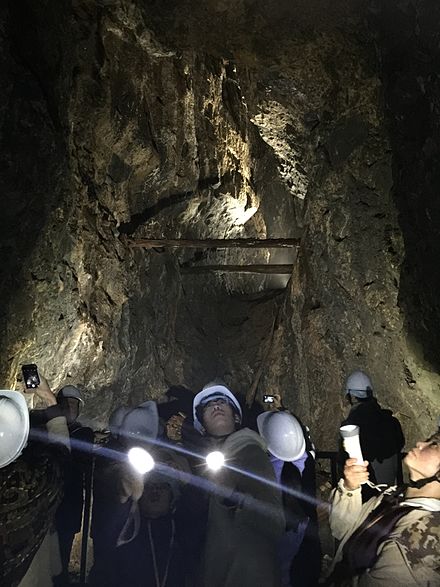Oda - city in Shimane Prefecture, Japan

Understand
Omori Town (near Iwami Town) is a fantastic old silver mining town, which accounted for about 1/3 of the world's silver production at its peak. Omori and the surrounding area had hundreds of silver mines of various sizes.
Get in
Oda city is accessible via Odashi Station along the San-in Line. Visitors most often take a train from Izumo (¥570); however, direct trains can be taken from as far as Tottori to the east and Yamaguchi to the west.
Get around
Several buses go up the main street. There are also bicycles for rent. You pay the rental fee at the gas station across the street. You can also walk, but it is a mostly uphill walk for about 2 km from the main starting point to the main mine.
See
- Nima Sand Museum (仁摩サンドミュージアム), 35.146389°, 132.40465°. 09:00-17:00. A museum about sand, featuring a large hourglass, sand samples from across Japan and the world, and lots of information about how sand forms and why there are different kinds of sand. ¥700 (Foreigners ¥350) 2017-11-01
Iwami Ginzan
 Iwami Ginzan (dead link: January 2023) (石見銀山) was one of the world's largest silver mines during the 16th and 17th centuries. At this time, one third of the world's silver came out of Japan, and Iwami Ginzan produced much of that silver, although many other mines existed. It was officially registered as a World Heritage Site in June 2007 under the name Iwami Ginzan Silver Mines and its Cultural Landscape, encompassing the mines, Omori Town, and Yunotsu.
Iwami Ginzan (dead link: January 2023) (石見銀山) was one of the world's largest silver mines during the 16th and 17th centuries. At this time, one third of the world's silver came out of Japan, and Iwami Ginzan produced much of that silver, although many other mines existed. It was officially registered as a World Heritage Site in June 2007 under the name Iwami Ginzan Silver Mines and its Cultural Landscape, encompassing the mines, Omori Town, and Yunotsu.
- Ryugenji Mabu Mine Shaft (龍源寺間步), Omori-cho, 35.0998336°, 132.4285898°, +81 854-89-0347. 09:00-17:00, to 16:00 winter. The only mine shaft that visitors can tour on their own without a tour, although guides are available. This covers only a fraction of the tunnels that were dug around here, but a walk through the shaft is impressive nonetheless. ¥400
- Okubo Mabu Mine Shaft (大久保間步), Omori-cho, 35.0955496°, 132.4434313°, +81 854-84-0750. Tours begin at 09:30, 10:30, 12:15, and 13:15, lasting 2½ hours. F-Su and holidays, Mar-Nov. The largest and most impressive mine shaft in Iwami Ginzan. It is open to the public for guided tours. Reservations are not necessary but are recommended, as a limited number are offered per week. Meet at the Iwami Ginzan World Heritage Center, where a bus will take you to the mines. Despite the time, effort, and money required, it's well worthwhile for a full appreciation of Iwami Ginzan. ¥3800
- Iwami Ginzan World Heritage Center (石見銀山世界遺產中心), 1597-3 Omori-cho, 35.105683°, 132.4495467°, +81 854-89-0183. 09:00-17:00. Typically the first stop visitors make when visiting the mines. This museum displays the history of the mines through artifacts, recreated scenes, and interactive computers. It's a nice place to prepare for everything you are about to see. ¥500
- Gohyaku-Rakan (五百羅漢, Rakan-ji 羅漢寺), 804 Omori-cho (along the road leading to the World Heritage Center), 35.1133823°, 132.4460539°, +81 854-89-0005. 09:00-17:00. An interesting temple cut into the side of the hill, housing 500 carved Boddhisatva statues. ¥500
Take a beautiful walk down the old single-street town up the hill on the way to the main mine; several old merchants homes, samurai homes and other buildings are restored. Beautiful houses. Tremendous wealth here at one time. There are several open houses along the way that you can pay to enter. You can also buy a pass that gives you admission to all of the open houses.
- Old Court House. Now a public hall. Has a 3D display of the geography around. Very interesting. Also a recreated scene of some miscreant receiving his sentence... must've been quite a bit of crime during the silver rush.... Easy to imagine this place in the boom years - like some scene from a Western, with swordsmen instead of gunslingers.
Do
Buy
- Gungendo (群言堂), 35.1147336°, 132.4454313°, +81 854-89-0077. Th-Tu 10:00-18:00. A very coolly stylish cafe and design gallery featuring handcrafted glassware, pottery, clothing, and decor.
Eat
Drink
Sleep
Hotels are scarce in the immediate Iwami Ginzan area.
Go next
By train, you can take a direct line to the following destinations:
Ōda Shi
2nd-order administrative division
Shimane Prefecture
Primary administrative division